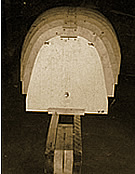
Work
started on pedal boat Moksha on April 2nd 1993. Using a timber storage
shed generously loaned by the Exeter Maritime Museum, Chris
and Hugo set to work lofting the designer’s
plans. Work then began constructing the boat using a cold-molded
technique. This gave the museum an 'in house' boat building feature
that was to prove very popular for the museums many visitors; who
frequently donated small amounts of cash to the expedition fund.
 |
>>
LOFTING is the technique
whereby full size slices of the shape of the hull are drawn
out as curves on the workshop floor to check for their smoothness
and accuracy. (This process has to be done with all new boat
designs from the marine architect's 'drawing board').
These
curved shapes are then transformed into plywood sections placed
diagonally along and upside down on a strong frame that runs
the length of the proposed hull.
This
upturned 'skeleton' provides the shape over which the hull
can then be built. Once the hull is completed, the framework
is dismantled and the empty shell created is turned up the
right way for work to begin on the insides and the topsides.
|
 |
>>
COLD-MOLDING is a relatively
modern technique made possible by the advent of technologically
advanced glues, and one of the stronger methods of building
a boat out of wood for it’s corresponding weight and
stiffness.
The
technique involves building up several thinner layers of wood
and wood veneer in long strips, gluing each layer diagonally
to the one below it with epoxy resin or other marine glues
to create something very similar to plywood, except that rather
than being in a flat sheet, it has a complex curved form (a
boat hull). This means there are no mechanical fastenings
through the hull shell as it is all one piece, and although
not as light as Carbon or Kevlar, the costs are much less
for a 'one off' production: Moksha cost around 25 thousand
pounds to build for around half of the equivalent cost in
Kevlar.
|
The
downside is that this method of boat building can be time consuming
compared to making a hull using a pre-prepared mould, which is more
suitable for multi-production of identical boats.
In
keeping with the environmental spirit of the expedition Moksha was
built with timber harvested from sustainable, responsibly managed
sources and supplied by the Ecological Trading Company in Bristol,
also with a variety of re-claimed odds and ends collected by the
dastardly duo Hugo and Chris. 30 mm wide strips of Western Red Cedar
from North America – just 10 mm thick - were secured with epoxy
resin to a frame of laminated mahogany ribs and sheathed with a
double and diagonally opposed skin of Hardwood Cachimbo veneers
(each one about 2mm thick) from Equador. The resultant hull is tough,
light, streamlined and watertight, guaranteed to right itself after
any capsize (oh look, there goes the moon!).
The
deck and cabin is constructed from marine ply with various hardwoods
and laminations used for stiffening and bracing the structure. Emergency
rainwater can be collected from the specially designed deck, but
only during periods of relatively calm seas. A hardwood rudder,
skeg and retractable centreboard constitute the boat’s steering,
helping to reduce side to side rolling motion and give the craft
some directional stability. The watertight sliding hatch and window
panels of bulletproof polycarbonate protect the central cockpit
area. All supplies for an ocean crossing are stored below the water
line in secure compartments that run down either side of the entire
length of the boat, providing the essential ballast needed for her
self-righting capability. Watertight hatches provide access to the
main forward and aft compartments, the former providing a 'shoulder
tight' sleeping berth for 1 x person at full stretch and the latter
dedicated entirely for the storage of spares, emergency supplies
and extra food. This means a 2x person crew will take it in turns
to pedal around the clock until landfall is made.
Beyond
the two main forward and aft compartments, at either end of the
boat there are watertight spaces each about 24 inches long. These
cannot be accessed from inside the boat and are dedicated buoyancy
and damage zones that may slow down or prevent water reaching the
main compartments in the event of collision or rudder damage. This
design has divided the boat into 5 independently watertight compartments
(rather like the Titanic). These 5 areas are connected to a dedicated,
high volume hand water pump in the event that one, or all should
need bailing after a mishap (like Jason spilling his tea).
Lastly,
the pedals drive, and are linked, directly via bevel gears to a
propeller under the hull. The system does not have any facility
for gear changes and does not make use of inertia from a flywheel.
In these respects, the propulsion system is completely different
to the type of paddle wheel system used on a ‘beach hire’
pedalo craft: a boat that people so often envisage when thinking
of pedal powered craft.
Chris
Tipper
>>
FIND OUT MORE ABOUT THE PEOPLE WHO BUILT MOKSHA >>
>>
CHECK OUT THE CONSTRUCTION PHOTO GALLERY TO LEARN MORE ABOUT HOW
MOKSHA WAS BUILT >>
>>
back to THE
PEDAL BOAT
|
